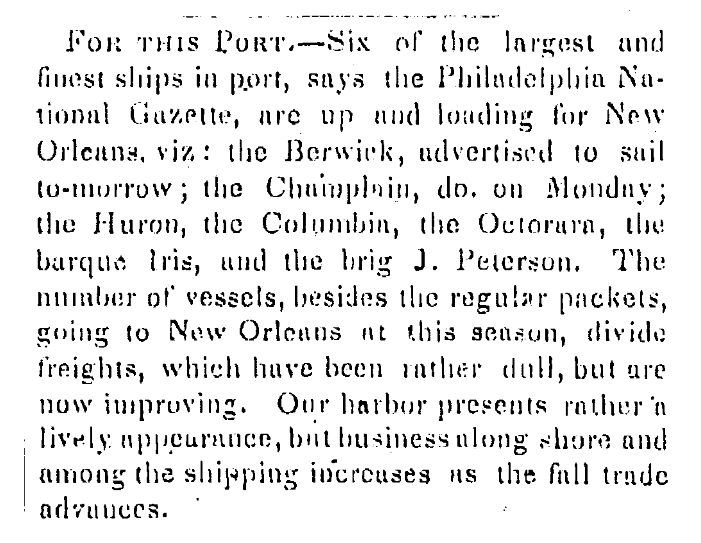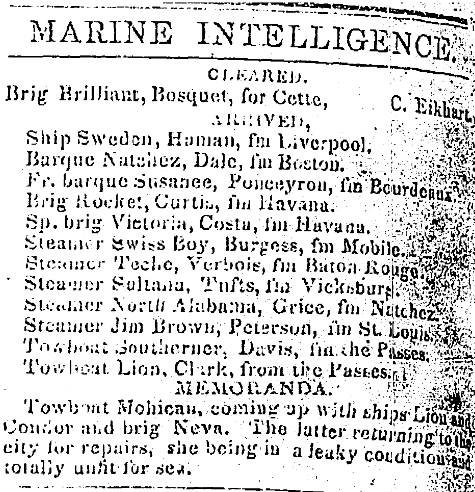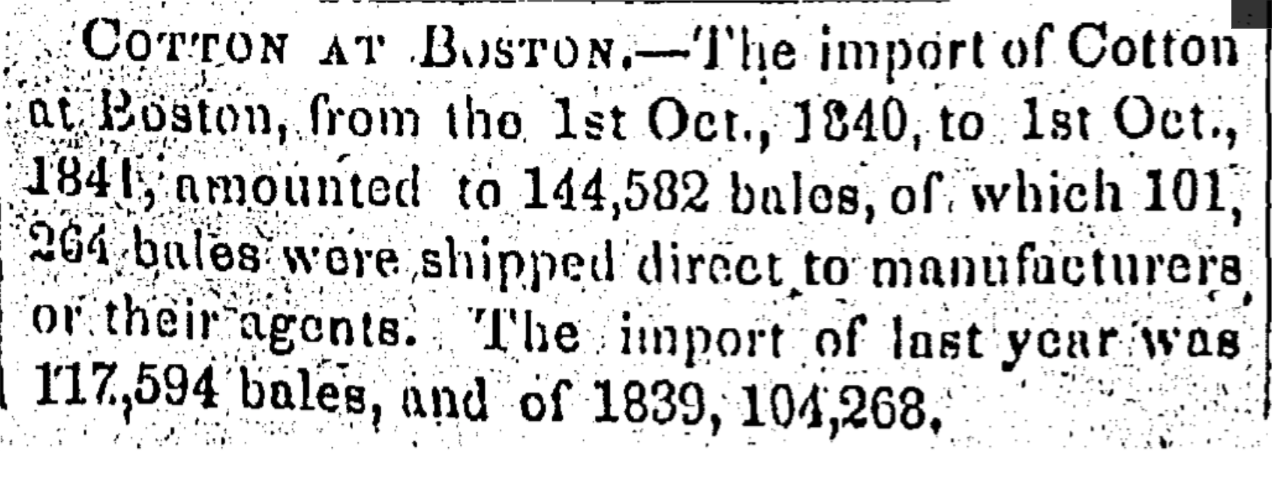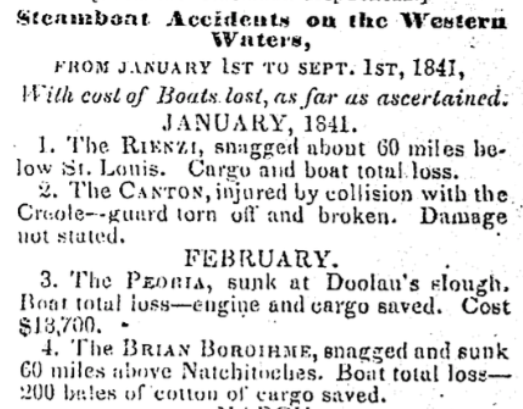Throughout the nineteenth century, New Orleans experienced a surge in economic growth and prosperity. In 1841, New Orleans was known as the unrivaled commercial center of the South and second only to New York City in the entire United States. This economic progress, however, lent itself to violence as it came at the expense of human lives and the preservation of nature. The concept of economic progress as a violent act can be seen throughout American history and is exemplified through the city of New Orleans’ means to economic prosperity in 1841.
In the 1800s, New Orleans transformed from a relatively isolated city in the Deep South to one of the most economically dominant cities in the country. In the early nineteenth century, New Orleans had its first big influx in population. By 1841, New Orleans was an economically established southern city. New Orleans owed much of its title as commercial center of the South to Mississippi River trade, various plantations, and the slave economy.

Excerpt from the Times Picayune, 1841

Marine Intelligence article from the Times Picayune in 1841
The arrival of the steamboat to the Mississippi River in 1812 opened a new realm of economic possibility for the city of New Orleans. The Mississippi River served as transportation for various American trading goods such as wheat, cotton, sugar, tobacco, molasses, and more. With the arrival of every steamboat and cargo ship, the Mississippi River proved itself as an invaluable player in the game of New Orleans’ economy. The river was also used as a means for transportation of people, providing New Orleans with a constant flow of tourists, trade, and culture. The white European society within New Orleans often publicly celebrated steamboats’ contribution to its booming economy. This is evident in the 1841 publications of a New Orleans newspaper, Times Picayune, where there were several articles a day reporting on the whereabouts of steamboats, steamboat crashes, and the state of steamboat trades.
The popularity of cotton trade was another key piece in the success of New Orleans’ economy in 1841. In the late eighteenth century, the invention of the cotton gin, revolutionized cotton production and allowed for cotton to emerge as the most important cash crop of the South throughout the antebellum period. Steamboat trade along the Mississippi River further increased the economic benefits New Orleans reaped from cotton production as it maximized cotton’s trading potential. By 1840, the city of New Orleans alone held 12 percent of the nation’s capital thanks to the combined forces of cotton production and Mississippi River trade.

Excerpt from Times Picayune, 1841
The success of the New Orleans economy at this time, however, came at a violent price. While steamboats were celebrated as a tool to further economic growth, the negative impacts of steamboats were largely brushed aside as a necessary cost of prosperity. Powering steamboats was a grueling and dangerous task. In order for the boat to drive, intense heat was necessary to boil water and make steam. The steam then needed to be pressurized to drive the boat. This task caused many explosions over the years, killing thousands and polluting the Mississippi River. The risk of explosion not only made steamboats an extremely dangerous method of transportation, but also resulted in huge expenses to replace the boat and account for the steamboat’s cargo. In addition to the risk of explosion, steamboats were highly accident prone. From January to August of 1841, there were 34 reported steamboat accidents along the Mississippi River, which was estimated to be less than one third of the actual accidents that occured. Each of these accidents cost tens or sometimes even hundreds of thousands of dollars, yet steamboats were still regularly used to transport goods and people.

List of Steamboat accidents from the Times Picayune, 1841
The constant use of steamboats on the Mississippi River industrialized and polluted what was once a pure form of nature. By the mid nineteenth century, thousands of steamboats were docking in New Orleans ports each year. Along with the contamination from steamboat explosions and accidents, the boats themselves were an environmental menace. Steamboats got their heat from coal, which would pollute the air and water, disrupting the ecosystems surrounding the riverbanks. At the time, the environment was a cost willing to be paid by the social elite in order to ensure economic growth.
Unarguably the most violent act in the name of economic prosperity in 1841 New Orleans was the utilization of slavery. New Orleans in 1841 was congested with enslaved people as they worked on plantations, in the service industries, and performed various jobs on steamboats. One of their jobs on steamboats was to feed the boilers of the boats, which exposed them to excessive heat and put them at risk to possible explosions. Although enslaved African Americans were the builders and workers of the Mississippi River trade system, they were not the ones who reaped the benefits of their hard work. This directly contradicts the foundational American ideology that if you work hard, you will prosper. In fact, the economics of New Orleans in 1841 proves the very opposite of this ideology as the most successful in New Orleans society at the time had enslaved people to labor in their stead.
The Mississippi River became a method of escape for African Americans seeking freedom from enslavement in the Deep South. These enslaved African Americans proved through their attempts at escape that they were willing to risk their lives in order to no longer be part of New Orleans’ economic progress. The brutal reality behind this progress uncovers the American dream as a guise of the violence behind economic advancement. This truth exemplifies how societal prosperity in New Orleans in 1841 was not made from the social elite’s hard work, but rather from the acts of violence the social elite were willing to commit in the name of financial gain.
 NOLAbeings
Multimedia artist Claire Bangser created NOLAbeings as a portrait-based story project that marries...
NOLAbeings
Multimedia artist Claire Bangser created NOLAbeings as a portrait-based story project that marries...
 Data corner: Adobe Suite (create a PDF, social media graphic, presentation, edit a photo and video
Data corner is where you go to work with analytics and top tech skills. It takes on everything from PERL and SQL to Canva and Sprout Social.
Data corner: Adobe Suite (create a PDF, social media graphic, presentation, edit a photo and video
Data corner is where you go to work with analytics and top tech skills. It takes on everything from PERL and SQL to Canva and Sprout Social.

HHAeXchange is a platform for home care management, connecting caregivers and agencies with tools for scheduling, timesheets, and compliance. hhaexchange+
It powerfully argues that the era’s economic prosperity was founded on both ecological my wisely destruction and extreme human violence, directly contradicting the American ideal of hard work leading to personal success. The text frames this economic advancement as a violent act, exposing the “American dream” as a cover for the systemic oppression and risk endured by enslaved African Americans.
It powerfully argues that the era’s economic prosperity was founded on both ecological https://www.my-wisely.org destruction and extreme human violence, directly contradicting the American ideal of hard work leading to personal success. The text frames this economic advancement as a violent act, exposing the “American dream” as a cover for the systemic oppression and risk endured by enslaved African Americans.
It exposes the dark realities behind progress, showing that prosperity often came at the cost of human lives, especially Harris County Texas Toll Roads Authority enslaved laborers, and severe environmental harm.